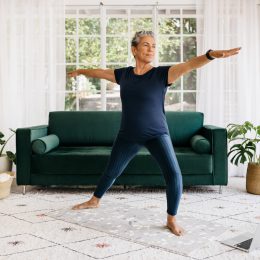Find Your Place: Assess Your Lower-Body Strength
How strong are your hamstrings? This quick test can tell you.
How high can you raise your heel off the floor, and how long can you hold it in that position? In this video, SilverSneakers fitness expert David Jack, along with physical therapist Mark Greenwood, explains how this quick test can give you clues about your lower-body strength.
You’ll need a sturdy chair. You may also want to perform this near a wall that you can hold on to if needed. Try the test now, then see what your results mean below. If you’re not able to stand on one foot safely, skip the test, but check out the tips below.
If You Were Able to Raise Your Heel Comfortably High and Hold It for 3 Seconds on Both Legs
That’s a sign your lower-body strength is average or above average. The benefits are clear: Lower-body strength allows us to get out of bed, stand on our feet, walk from point A to point B, and power all types of movement. More than that, a strong, flexible lower body helps prevent back, hip, and knee pain.
Preserve your lower-body strength with this 30-minute strong-foundation workout. Pair it with flexibility exercises—like these five stretches that are perfect after any walk or workout—for a well-rounded routine.
If You Weren’t Able to Raise Your Heel Very High or Hold It for 3 Seconds on Both Legs
That’s a sign your lower-body strength may be below average. It may also be a sign your lower-body flexibility could use some work.
Here’s what may be happening: Your hamstrings, which are the muscles in the back of your thighs, can’t contract well enough to help raise your heel. Your quadriceps, which are the muscles in the front of your thighs, are too tight—restricting movement in your hamstrings.
Adding the split squat can help solve both problems. It’s a two-for-one exercise that strengthens one leg while stretching the other. Watch a video and see a step-by-step guide to the split squat here.
Want the guidance of a fitness instructor? SilverSneakers classes can help you improve your lower-body strength as well overall fitness.
Subscribe to our newsletter
It's quick and easy. You could be one of the 13 million people who are eligible.
Already a member? Click to discover our 15,000+ participating locations.
Follow Us
If You Weren’t Able to Take the Test or Have a Chronic Condition
The first thing to remember is physical activity is safe—and beneficial—for almost everyone, according to the latest fitness guidelines. The key is working with your doctor to find the right plan for you.
Start by talking to your doctor about your current health and any medications you take. Ask these three questions:
- What types of exercise are appropriate for me?
- How often and how much should I do them?
- Are there precautions or steps I should take? For example, people recovering from an injury may need additional treatment or physical therapy. People with knee pain will want to prioritize good form during exercises.
Check Your SilverSneakers Eligibility Instantly
SilverSneakers gives you free, unlimited access to more than 15,000 gyms and fitness centers across the nation, plus classes and tools designed to keep older adults strong and independent. Check your eligibility instantly here. Already a member? Get your SilverSneakers member ID and exclusive content by logging in to or creating your online account here.





